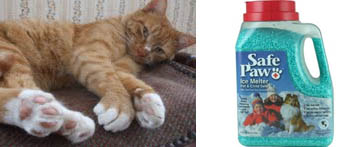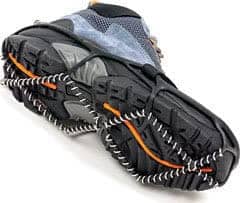By Jennifer Silver, JMMDS
Note (11/7/17): This post was written in 2011. We just came across a current and thoroughly-researched article with more up-to-date information about non-toxic de-icers on the Epic Gardening blog. You may want to click over and check it out!
Those of us who live in snowy climates are besieged by choices when it comes to melting ice and snow on our walkways, driveways, and stairs. Keeping in mind that any product we use is going to remain in our soil and waterways long after winter has passed, we want to make responsible choices. We did some research and learned that although no product is perfect, some choices are much better than others, and that a “green” or “pet-safe” label can be very misleading!
 Even having fuzzy feet may not be enough to prevent a fall—sometimes you need a little help. Photo: funny-games.biz.
Even having fuzzy feet may not be enough to prevent a fall—sometimes you need a little help. Photo: funny-games.biz.
The criteria
We want de-icing products that are:
- Effective
- Safe for ourselves, our families, our pets, and other living creatures in our environment
- Not harmful to our landscape plantings, our food crops, and the vital organisms in our soil
- Not corrosive to our vehicles, homes, driveways, sidewalks, steps, and interior surfaces such as flooring and carpets
De-icing products are an unregulated industry. Some products make laughably false claims to be “eco-safe,” “environmentally friendly,” or “pet-safe.” Don’t trust the names! Instead, look for the ingredients list (which can be suspiciously tricky to find on those “eco-safe” packages!) and decide for yourself.
Look past the product name and read labels carefully to find out what you’re getting. Morton Safe-T-Plus EcoSafe Ice Melt contains sodium chloride, or rock salt. Paws Applause and Keep It Green contain fertilizers. L photo: Morton Salt. C photo: Maine Salt Company. R photo: Amazon.
The Usual Suspects: De-Icing Ingredients
Rock salt (sodium chloride): The traditional de-icer—and one of the least safe. Sodium chloride contains both cyanide and chloride and, according to this source, “also releases the highest amount of chloride ions when it dissolves. Chloride can pollute streams, rivers and lakes. The chloride also causes metal to corrode.”
Calcium chloride: Made by extracting salt from limestone or as a by-product of other processing. Calcium chloride is much more effective than rock salt at melting ice and snow at low temperatures; however, says this source, “there is some evidence that the product may be more harmful to live plants than rock salt.” Calcium chloride is toxic to pets and children and is easily tracked inside where it can do damage to carpets and floors.
Magnesium chloride: Very effective, often used in its liquid form on highways, available in crystal form for home use. Magnesium chloride is hailed as a safe alternative to rock salt and calcium chloride, although opinions vary. One study found magnesium chloride to have a minimal environmental impact on wetlands species near roadways. In 2001, however, the USDA published an article that claimed that magnesium chloride led to “corrosion of steel and aluminum poles and pole hardware.” Another source mentions that its use can lead to corrosion of vehicles and electric utilities.
Potassium chloride: Reported to be safer than the products above for vegetation and other living things. The limitation of potassium chloride is that it is effective only above 15˚ F.
All of the chloride de-icers dry out pets’ paws, which can cause painful cracking and bleeding. It is best to avoid these ingredients if you have pets. Although some de-icers have ingredients that are toxic if ingested, it is rare for animals to eat them in sufficient quantities to be poisoned.
Additionally, if you have cement walkways or steps, note that calcium chloride, potassium chloride, and sodium chloride can physically damage cement as the cement repeatedly undergoes the freezing and thawing cycle and the expansion pushes apart the concrete molecules. Although some sources claim that magnesium chloride is safer than calcium chloride to concrete, there is evidence that magnesium chloride has an even more damaging effect on cement because it attacks the structure of concrete both physically and chemically.
Fertilizers: Beware de-icers that call themselves eco-friendly (and some even have “green” in their names!) but are actually made with urea and other fertilizers. These run off into local water sources, cause algae bloom, and kill fish, plants, and other species. We do not recommend the use of fertilizers as de-icers. They contain ammonium nitrate and sodium nitrate and are damaging to the environment, despite labels’ claims that when the snow melts in spring, your plants will benefit from the fertilizer crystals. Furthermore, they are not effective ice-melters and do little more than provide traction (see below for eco-friendlier methods).
Our recommendations:
Safe Paw: Safe Paw is a product marketed as non-toxic for pets and people. According to the company website, “Safe Paw’s patented dual-effect compound, made up of a crystalline amide core infused with special glycols.” I found no information on ill effects from these ingredients. Safe Paw is effective down to 2˚F. In our northeast climate, therefore, when temperatures dip below zero, it should be used in combination with one of the options below. Safe Paw is relatively expensive, but I consider it an acceptable investment, weighed against hurting paws and landscape and property damage.

Protect those little pink paws, using a de-icer like Safe Paw, which contains none of the salts that cause pets’ paws to crack. L: Red the cat, annoyed at having his picture taken, but happy that his feet don’t hurt. Photo: Jennifer Silver. R: Safe Paw.
The non-slip options: There is a product called EcoTraction, made of volcanic mineral granules which do not melt ice and snow but instead provide traction to prevent slipping. This product contains no toxic materials and can be swept up and re-used.
A local (and free!) alternative: I take a 5-gallon bucket to the town garage, where sand is available for free (this is the same sand spread by the road crews). We sprinkle the sand on our shoveled walkway as needed, and it works very well—no slips, no falls. In the spring, we can sweep it up and use it elsewhere. Call your town to see if you are permitted to help yourself to road sand. (Strictly speaking, sand contains silica, which has been found to be carcinogenic—but that doesn’t stop me from going to the beach, or putting it on my walkway.)
Another free and truly green alternative: The mother of one of our designers cuts up her Christmas tree and scatters the branches where traction is needed. Clever re-use! We also like the ice traction slip-on devices you can wear over your shoes.

Several members of our team swear by Yaktrax and similar slip-on traction devices. Just be sure to take them off before you walk on the Aubusson carpet. Photo: Yaktrax.
Have a safe snow season, and please tell us about the products or methods that work for you!







thanks for the post! even zone 6B in virginia this year has to deal with ice, freezing rain, snow, slush, and constant refreezing. with your permission, I’d like to reblog this post.
Hi Virginia. You are welcome to reblog–thanks for asking. Apparently even Hawaiians are dealing with it this year. Good luck with the weather predicted for later this week!
Thanks for mentioning Safe Paw. Safe Paw is a unique product that is completely different from any other Ice Melter. We take great pride in being the #1 selling Safest Ice Melter on the market. In addition, Safe Paw is extremely effective, down to -2 deg f. Safe Paw can be used on all surfaces and is safe for plants and shrubs. Safe Paw also is guaranteed safe for your family, children and pets. Safe Paw is the only Ice Melter guaranteed safe for ingestion. Try it and you’ll love it.
Thank you so much for this extremely helpful post, Jennifer! It answers a lot of questions that I’ve had since moving to Vermont.
Thank you for this good information. I have pondered the “environmentally safe” products. Now I know. They really should be regulated, shouldn’t they?
I always buy a 20 lb bag of coarse sand at Lowes or any other place that sells home improvement products. You will find it next to bags of cement. Finer sand (for sandboxes) is prettier and works too, but not as well. -It costs only a few dollars. I keep it in an old coal scuttle by the door. During every break in the weather I sweep it up and throw in back in the scuttle. Take off your shoes when you come in the door.
I agree with Karen and do the same =- the best.
Also, try Kitty Litter – it works well for giving cars traction on the ice as well, and is less heavy than carrying bags of sand in your car. I do not like it as much for walkways as it tracks inside too much.
I live in the Gatineau Hills outside Ottawa, where Eco-traction is a local success story. It is a great, very environmentally-friendly product, which I don’t hesitate to use on my flagstone walkway and gravel driveway… Its only downside is that if it gets onto our painted wood porch floor, it grinds through the paint. We’ve put down a coir runner which seems to be working well there.
Your blog is fantastic.
Valuable information. Lucky me I discovered your site accidentally, and I am surprised why this coincidence did not happened in advance! I bookmarked it.